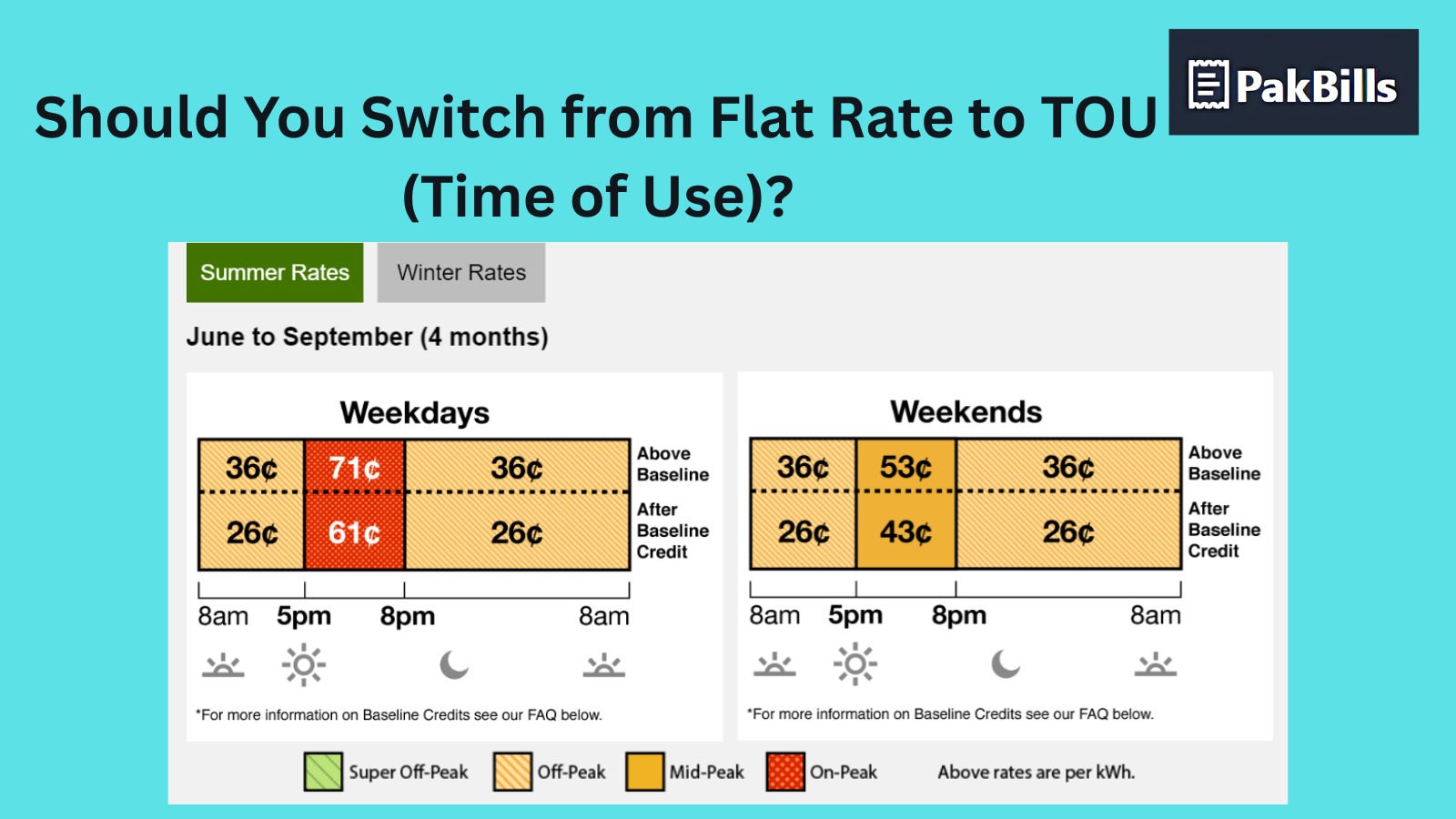Should You Switch from Flat to TOU Billing for Electricity?
.png)
As electricity prices continue to rise in Pakistan, many consumers are exploring different billing options to cut down on costs. One of the most talked-about alternatives is switching from a flat rate to TOU (Time of Use) billing. While flat rates charge you a fixed price per unit no matter the time, time-of-use electricity rates vary depending on when you use electricity — peak hours are more expensive, and off-peak hours are cheaper. In this blog, I’ll walk you through what TOU really means, how it works, and share my real-life TOU review after switching from a flat rate plan. If you’re considering the change, read on to find out if it’s right for you.
What Are TOU (Time of Use) Electricity Rates?
Time-of-Use electricity rates are designed to reflect the demand on the power grid. During peak hours — typically in the evening when everyone’s home using appliances — electricity is more expensive. In contrast, during off-peak hours such as late night or early morning, rates are lower. With a smart meter, your electricity provider can track the exact time you use electricity, making TOU billing possible. These smart devices record hourly usage, allowing for a more dynamic and efficient billing system. So, why are utilities moving toward TOU? Because it helps them manage demand more efficiently. It encourages people to use electricity during off-peak hours, reducing stress on the grid.

Flat Rate vs TOU: Key Differences
Here’s a quick comparison between the two billing models:
Feature
|
Flat Rate
|
TOU (Time of Use)
|
|
Pricing |
Fixed per unit |
Varies by time of day |
|
Predictability |
High |
Depends on usage timing |
|
Behavioural Impact |
No need to adjust habits |
Encourages off-peak usage |
|
Potential Savings |
Low if consumption is steady |
High if usage is flexible |
|
Meter Type |
Regular meter |
Requires a smart meter |
While flat rate offers stability, TOU rewards smart usage. Explore more energy-saving tips for homeowners.
My Personal Experience Switching to TOU
The Decision Process
I first heard about TOU plans when I noticed my friend’s electricity bill had dropped significantly. Curious, I compared various utility rate plans and saw that TOU had the potential for big savings — if I adjusted my usage habits. The idea of being rewarded for using power at non-peak times made sense, especially since I worked from home with a flexible schedule.
The First Electricity Bill
After the switch, I was excited but a bit anxious. I was cautious about running appliances during peak hours. When my first bill arrived, I compared it to my previous flat rate bills. To my surprise, I had saved around 15%, even without fully optimizing my habits.
Tracking Savings Over Time
Over the next few months, I became more strategic — doing laundry at night, using fans during peak times instead of AC, and running the dishwasher early in the morning. These small shifts added up. By the third billing cycle, my overall bill was about 25% lower than my average under the flat rate plan. This positive electricity bill comparison TOU vs flat rate was enough to convince me that TOU works — with a little effort.
Pros and Cons of TOU vs. Flat Rate
Let’s break down the pros and cons:
Pros:
- Potential for cost savings if you manage your timing.
- Increases usage awareness and energy efficiency.
- Encourages environmentally friendly habits.
- Flexible users benefit the most.
Cons:
- More complexity than flat rate billing.
- Time restrictions can be limiting.
- Peak rates can be harsh if not monitored.
Is TOU Right for You? Consider These Factors
Switching from flat rate to TOU isn’t for everyone. Here’s who can benefit the most:
- People with flexible work hours who can shift usage to off-peak times.
- Those with energy-smart homes using automation or timers.
- Night owls or early risers who don’t mind off-peak living.
However, if your family uses a lot of power during the evening, or you have small children or fixed routines, TOU might not offer savings — and could even cost more.
Check out our electricity usage guide to learn about usage patterns across different hours and seasons.
Tips to Maximize Savings on a TOU Plan
If you decide to go TOU, here are some practical energy cost savings tips to make the most of it:
- Run major appliances (washing machine, AC, water heater) during off-peak hours.
- Install smart thermostats and programmable timers for ACs and geysers.
- Use your utility’s mobile app or web portal to track your hourly usage.
- Avoid heavy usage from 6 PM to 10 PM — the peak vs off-peak electricity pricing difference is significant.
Learn more by reading Understanding Peak and Off-Peak Hours.
Conclusion
After using TOU billing for over 6 months, I can say it’s worth considering — but only if you're ready to change some habits. I’ve seen measurable savings, and my family is now more aware of how and when we use electricity. That said, TOU vs. flat rate pros and cons should be carefully weighed. It’s not a one-size-fits-all solution. If you want control over your electricity costs and can adapt your schedule, TOU can reward you with real savings.
FAQs
How much can I save with TOU rates?
Depending on your usage patterns, savings can range from 10% to 30%. Users with flexible schedules benefit the most.
What happens if I use energy during peak hours?
You’ll be charged a higher rate. Avoid running heavy appliances between 6 PM and 10 PM.
Can I switch back to a flat rate plan if I don’t like TOU?
Yes, most utility providers allow users to switch back after a specific period, but policies vary by region.

Loading comments...